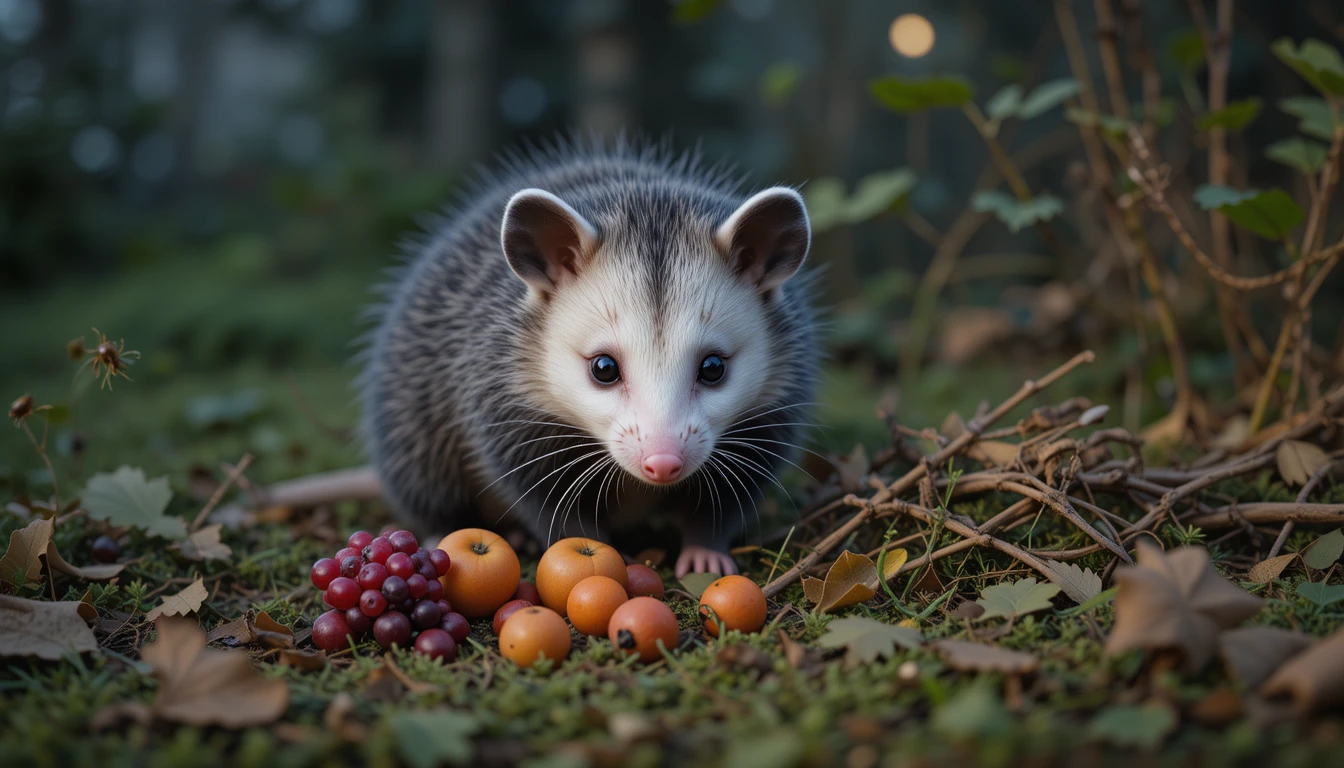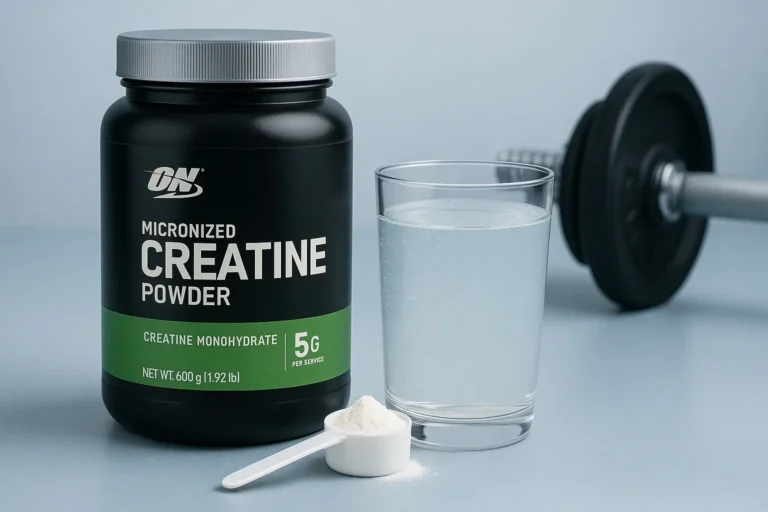Opossums eat up to 4,000 ticks per week, helping reduce Lyme disease in your backyard. These helpful animals have one of the most varied opossum diets of any North American animal.
Learning what opossums eat helps us see their value and live alongside these fascinating creatures.
What Are Opossums and What Do They Eat?
The Virginia opossum is North America’s only marsupial (an animal with a pouch). These adaptable creatures are often feared, but they’re gentle animals that help our local ecosystems in many ways.
According to the National Wildlife Federation, opossums live from southern Canada to Central America. You can find them in forests, fields, and even in your neighborhood. They’re about as big as a house cat, with gray fur, a pointed face, and a naked tail.
What makes the opossum diet special is how flexible it is. This dietary adaptability has helped opossums survive for millions of years – even outlasting the dinosaurs!
To learn more about adaptable animals, check out our article on 15 Dopamine Brain Foods to Boost Mood, which explains how certain foods help our bodies adapt to stress.
The Complete Opossum Diet: What Do Opossums Eat?
Opossums are true omnivores with one of the most varied diets of any animal. Research from the Journal of Wildlife Management shows they eat over 400 different foods. This wide opossum diet helps them thrive in many different places.
| Opossum Food Category | Examples | Benefits to Ecosystem |
|---|---|---|
| Insects & Bugs | Ticks, cockroaches, beetles | Pest control, disease reduction |
| Small Animals | Mice, rats, small snakes | Rodent control |
| Carrion (Dead Animals) | Roadkill, winter carcasses | Clean up, prevent disease spread |
| Fruits & Berries | Persimmons, blackberries, apples | Seed dispersal |
| Plants & Vegetables | Grasses, garden vegetables | Minimal plant damage |
| Human Sources | Pet food, compost, garbage | Less wasteful than other wildlife |
Just like you might enjoy the diverse diet in our Healthy Nachos: 15 Guilt-Free Mexican Recipes, opossums thrive on variety in their diet!
Animal Foods in the Opossum Diet
Insects and Other Bugs
- Ticks: One opossum can eat 4,000+ ticks weekly, says the Cary Institute of Ecosystem Studies
- Cockroaches, beetles, and crickets
- Snails and slugs
- Earthworms
- Spiders
Small Animals
- Mice and rats
- Small snakes (opossums are resistant to most snake venom)
- Lizards and frogs
- Small birds and their eggs
Dead Animals (Carrion)
- Roadkill and other animal remains
- Deer carcasses during winter
Plant Foods Opossums Eat
Fruits
- Wild berries: blackberries, blueberries
- Persimmons (a favorite)
- Apples, grapes, and other fruits
- Pawpaws and mulberries
Other Plant Matter
- Grasses and leaves
- Nuts and seeds
- Corn and grains
- Garden vegetables
- Mushrooms
Other Opossum Food Sources
- Human food waste
- Pet food left outside
- Bird seed from feeders
- Garbage
The Missouri Department of Conservation notes that this flexible opossum diet is key to their survival, letting them thrive in different conditions and adapt to seasonal food changes. Similar to how we might switch up our diets with the seasons, as shown in our article 7-Day Intermittent Fasting Meal Plan for Weight Loss, opossums adapt their eating to what’s available year-round.
What Do Opossums Eat in Different Seasons?
Opossums change their diet throughout the year based on what’s available. A study in the Journal of Mammalogy found these seasonal changes:
| Season | Main Foods in Opossum Diet | Eating Behavior |
|---|---|---|
| Spring | Insects, small animals, early berries | Active foraging at night |
| Summer | Fruits, berries, insects, garden produce | Peak activity and eating |
| Fall | Nuts, seeds, fruits, preparing for winter | Building fat reserves |
| Winter | More carrion, stored foods, human sources | Limited foraging in cold |
Spring Diet
- More insects become available
- Small animals, including baby rabbits
- Early berries and fruits
- Fresh grasses and shoots
Summer Diet
- Lots of fruits and berries
- Many insects, including ticks
- Garden vegetables
- Small prey animals
Fall Diet
- Nuts, seeds, and late fruits
- More scavenging as winter approaches
- Insects until first frost
- Foods that help build fat
Winter Diet
- More dead animals (carrion)
- Stored fruits and nuts when available
- More human food sources (garbage, pet food)
- Bark, twigs, and stored seeds
The North American Wildlife Conservation points out that during cold winters, opossums may struggle to find enough food. Their bare ears, tail, and feet can get frostbite, which limits how far they can go looking for food when it’s cold.
How Do Opossums Find and Eat Their Food?
Opossums have developed special ways to find and eat their varied diet. According to the American Society of Mammalogists, these methods include:
Sensory Adaptations for Finding Food
- Great sense of smell: Their main hunting tool, helps them find food in the dark
- Sensitive whiskers: Help navigate and find food in dark or thick areas
- Good hearing: Detects moving prey and threats
- Poor eyesight: Mainly sees movement and light changes
Physical Features That Help Them Eat
- Gripping tail: Helps with climbing to reach fruits
- Thumbs on their back feet: Great for grabbing branches and food
- 50 teeth (more than any other North American animal): Perfect for their varied diet
- Strong jaws: Can crush shells and bones of small prey
Hunting Behaviors
- Night activity: Most active at night, less competition and danger
- Slow, careful searching: Examining leaves, fallen logs, and hiding places
- Opportunistic eating: Taking whatever food they find
- Hunting alone: Usually forage by themselves to maximize food intake
If you’re interested in how animals adapt to different diets, our article on 10 Science-Backed Ways to Boost Your Brain explores how brain health is affected by what we eat, similar to how opossums have adapted their feeding strategies over millions of years.
Why the Opossum Diet Makes Them Valuable Neighbors
The varied eating habits of opossums provide several important benefits to our environment:
| Ecological Benefit | How Opossum Diet Helps | Comparison to Other Animals |
|---|---|---|
| Tick Control | Eat 4,000-5,000 ticks weekly | Eat 3-4 times more ticks than most mammals |
| Pest Control | Eat roaches, rats, mice | More efficient than cats for some pests |
| Cleanup Services | Consume carrion and fallen fruit | Less messy than raccoons or skunks |
| Seed Spreading | Spread seeds through droppings | Help regrow native plants |
Tick Control and Disease Reduction
Research from the Tick Encounter Resource Center at the University of Rhode Island confirms that opossums eat thousands of ticks per season. Since ticks spread Lyme disease and other serious illnesses, opossums provide a valuable public health service.
Pest Control
By eating cockroaches, rats, mice, and other household and farm pests, opossums act as free pest control. The National Pest Management Association recognizes their role in keeping rodent populations down.
Waste Management
Opossums are nature’s cleanup crew. By eating dead animals and fallen fruit, they help reduce disease spread and return nutrients to the ecosystem. Scientists at Cornell University have studied how scavengers like opossums improve ecosystem health through waste removal.
Seed Spreading
After eating fruits and berries, opossums spread seeds through their droppings, helping to regrow plant communities. According to the Natural Resources Conservation Service, this seed spreading is critical for keeping forests healthy and diverse.
This is similar to how some healthy foods help our own bodies regenerate, as explained in our article on The Joy of Fermented Foods: A Journey to Better Health.
What Nutritional Needs Do Opossums Have?
To support their active lifestyle, opossums have specific food needs. Research from the Journal of Zoo and Wildlife Medicine highlights several important aspects of opossum nutrition:
Protein Needs
Opossums need lots of protein, especially:
- During growth phases (baby opossums)
- In breeding females
- During winter months when building fat reserves
Fat Consumption
- Opossums seek high-fat foods, particularly before cold weather
- Adult opossums can develop significant fat layers during fall
- They cannot hibernate, so stored fat provides essential energy during food scarcity
Calcium and Other Minerals
- Critical for marsupial bone development
- Often obtained by consuming small bones, snail shells, and mineral-rich soils
- Deficiencies can lead to metabolic bone disease
Vitamin Requirements
- Vitamin D is essential for calcium metabolism
- B vitamins support neurological function
- Often obtained through varied diet and gut microbiome synthesis
Do Opossums Eat Human Food?
As human areas expand into natural places, opossums increasingly find food from human sources. The Humane Society of the United States notes several common interactions:
Pet Food
- Open bowls of cat or dog food are major attractants
- High in protein and easy to access
- Can create dependency if consistently available
Garbage and Compost
- Food waste provides easy meals
- Compost piles contain both plant matter and invertebrates
- Secure containers can prevent access and unwanted visits
Gardens and Orchards
- Ripe fruits and vegetables are attractive food sources
- May consume pests like slugs and insects while visiting gardens
- Generally cause less damage than other wildlife like raccoons
Just as we need to watch what kinds of snacks we eat for health reasons, as discussed in our article 25 Cheap Healthy Snacks: Affordable Options for Smart Eating, it’s important to consider what human foods opossums might access in our yards.
Common Myths About What Opossums Eat
Several myths exist about what opossums eat, leading to unnecessary fear. The Wildlife Rehabilitation Center of Minnesota helps clarify these misconceptions:
| Myth | Reality | Facts About Opossum Diet |
|---|---|---|
| “Opossums eat baby animals” | They rarely eat healthy young animals | They prefer easier meals like insects and fruit |
| “Opossums kill and eat pets” | They almost never attack pets | They’re non-aggressive and prefer to flee |
| “Opossums make a mess with garbage” | They eat in place, causing minimal mess | Unlike raccoons, they don’t scatter trash |
| “Opossums eat lots of chickens and eggs” | They rarely take healthy chickens | They might eat already dead poultry or occasional eggs |
Myth: Opossums Mostly Eat Other Animals’ Babies
Reality: While opossums occasionally eat eggs or very small animals, they prefer easier meals like insects, fruits, and dead animals. They’re too slow to catch healthy adult animals or well-protected babies.
Myth: Opossums Kill and Eat Cats or Small Dogs
Reality: Opossums are non-aggressive and more likely to run away than fight. They pose virtually no threat to pets and would only eat a pet if they found it already dead.
Myth: Opossums Spread Garbage Everywhere
Reality: Unlike raccoons, which may scatter trash widely, opossums typically eat in place, causing minimal mess. They lack the dexterity that makes raccoons messier foragers.
Myth: Opossums Mainly Eat Chickens and Their Eggs
Reality: While they might take eggs or injured/dead poultry, healthy chickens are usually safe from opossums, which prefer easier meals. Simple coop security measures can prevent any issues.
For more information about how different animals benefit our local ecosystems, check out our article on 10 Healthy Ice Cream Ideas for Weight Loss & Wellness, which discusses how natural ingredients support our health, much like opossums support ecosystem health.
Should You Feed Opossums?
Many people wonder if they should provide food for visiting opossums. Wildlife experts from the USDA Wildlife Services and state wildlife agencies generally advise against intentional feeding for several reasons:
Why Feeding Opossums Isn’t Recommended
- Creates dependency on human food sources
- May increase disease spread among gathering animals
- Can lead to habituation and loss of natural foraging behaviors
- May attract unwanted wildlife like rats or raccoons
- Could create conflicts with neighbors
Better Ways to Support Opossums
- Keep natural areas with native plants
- Allow fallen fruit to remain briefly before cleaning up
- Create brush piles that attract insects (opossum food)
- Install wildlife-friendly water sources
- Reduce pesticide use to preserve insect food sources
- Keep compost well-managed but accessible
What Do Captive Opossums Eat?
For wildlife rehabilitators caring for injured or orphaned opossums, diet is very important. According to the Opossum Society of the United States, proper nutrition includes:
For Adult Opossums in Rehabilitation
- High-quality dog or cat food (typically 28-32% protein)
- Fresh fruits and vegetables (apples, berries, sweet potatoes, greens)
- Calcium supplements
- Occasional lean meats, hard-boiled eggs, or insects
- Limited treats for enrichment and medication delivery
For Orphaned Baby Opossums
- Specialized marsupial milk replacer
- Gradually introducing solid foods
- Higher calcium and protein requirements
- More frequent feeding schedule
Foods to Avoid Giving Opossums
- Cat food exclusively (too high in fat)
- Dairy products (opossums are lactose intolerant after weaning)
- Processed human foods
- High-sugar foods
- Chocolate and caffeine
- Onions and garlic
- Avocado (potential toxicity)
For more information on proper animal nutrition and how diet affects health, check out our article 7 Surprising Russet Potato Nutrition Facts, which explains how even simple foods can have complex nutritional benefits.
Conservation and Coexistence
Understanding the opossum’s diet helps us appreciate their ecological role and coexist with these beneficial creatures. The National Wildlife Federation offers these suggestions for positive opossum interactions:
Creating Opossum-Friendly Habitat
- Plant native fruit-bearing trees and shrubs
- Maintain leaf litter and natural ground cover where possible
- Create rock piles or brush heaps that attract invertebrates
- Reduce pesticide use to preserve their natural food web
Preventing Unwanted Opossum Visits
- Secure garbage in animal-proof containers
- Feed pets indoors or remove outdoor dishes at night
- Harvest ripe fruit promptly from gardens
- Secure compost in wildlife-resistant bins
- Block access to crawl spaces and under decks
Helping Opossums Safely
- Drive carefully at night when opossums are active
- Check pouches of females found dead on roads (joeys may survive)
- Contact wildlife rehabilitators for injured or orphaned opossums
- Support local wildlife conservation efforts
Conclusion: Appreciating Nature’s Cleanup Crew
The opossum’s diverse diet makes them one of nature’s most efficient cleanup crews. By consuming problematic insects, small rodents, carrion, and overripe fruit, they provide valuable ecosystem services while asking little in return.
Rather than fearing these misunderstood marsupials, we can appreciate their role in maintaining healthier ecosystems. Their consumption of disease-carrying ticks alone should earn them a place of honor in our backyards and wild spaces.
By understanding what opossums actually eat—versus what myths suggest—we can make informed decisions about how to coexist with these beneficial neighbors. Their remarkable dietary adaptability has helped them survive for millions of years, and with our support, they’ll continue providing their clean-up services for millions more.



Leave a Comment